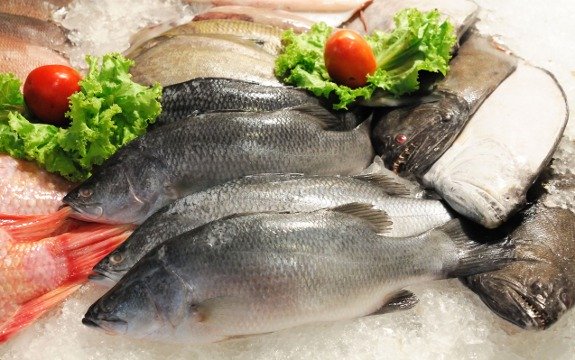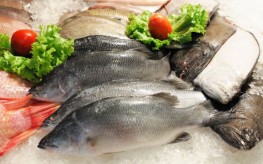Where is Your Fish From? 6 Things You may Not Know About the U.S. Seafood Supply

Seafood consumption in the United States hovers at around 15 pounds per person per year. This is in stark contrast to the 110 pounds of red meat consumed per person per year. Adding more seafood into your diet isn’t as simple as it may seem, however, as many people know less about where there seafood is coming from and how to ensure it is safe.
in the United States hovers at around 15 pounds per person per year. This is in stark contrast to the 110 pounds of red meat consumed per person per year. Adding more seafood into your diet isn’t as simple as it may seem, however, as many people know less about where there seafood is coming from and how to ensure it is safe.
Here are 6 things you may not know about the U.S. seafood supply:
1. 85% of Fish and Shellfish Consumed in the U.S. is Imported
Maine may have amazing lobsters, and the gulf is a great place for shrimp, but the overwhelming majority of seafood we eat comes from elsewhere.
According to Food Safety News, some of the imported fish can trace ancestry to the States. Bay scallops imported from China account for half of the bay scallops we eat. Though they come directly from China, they were taken there from Martha’s Vineyard. A Chinese scientist ate some of the Martha’s Vineyard scallops and took 120 back to China with him in 1982. Twenty-six survived and became the genetic basis of those we import today.
2. 55% of Seafood Consumed in the U.S. is Limited to Shrimp, Canned Tuna, and Salmon
We know what we like, apparently. About 90% of the seafood and shellfish Americans consume come from only 10 different types of fish and shellfish, according to Seafood Health Facts. Our consumption habits have changed little aside from the increasing presence of tilapia in our diet.
Read: 5 Facts About Farm-Raised Fish You Should Know
3. Thai Shrimp Accounts for Most of our Shrimp Imports
Shrimp production in Thailand isn’t without controversy. Recently, it was discovered that the industry relies on slave labor for collecting fish meal to feed the shrimp. Further, a shrimp disease called Early Mortality Syndrome wiped out billions of dollars in shrimp over the past year.
4. Your Wild Seafood may be Illegally Caught
According to Food Safety News:
“Illegal, unreported and unregulated (IUU) fishing accounts for a large portion of the global catch. A recent study in the journal Marine Policy found that as much as 30 percent of the wild fish the U.S. imports comes to us illegally, e.g., it’s outside any management system whatsoever.”
5. Salmon: We Import as Much as we Export
Sounds fishy, right? While wild caught Alaskan salmon is exported across the globe, Americans mostly consume farm-raised salmon from places like Chile.
6. Sometimes, We Export and Import the Same Fish
As for the wild caught Alaskan salmon that we do keep, it may have traveled to China for processing and packaging. It’s China’s cheap labor that makes it cost-effective to freeze and send Alaskan fish to the Eastern country for boning and packing before bringing it back stateside.

It is apparent to me that China has no reason Not to start poisoning us through fish injections of bacteria and viruses. War is looming and Satan is controlling the minds of the enemy abroad and within. It would be so easy. So perfect. So predictable.
But our media’s minds and Americans brains are silent, doomed and project a blank screen upon society’s daily life.
Ooooh Scary!
China has already poison many of their young with poisonous baby formula. Those people already got the firing squad. No wasted tax payer money to give to criminals on death row for the Chinese. And China has already killed some of our pets with toxic pet food.
But really iguana one, “Satan is controlling the minds of the enemy abroad and within.” Give me a break!
With the Chinese now sending us food it sort of reminds me of the Elois’ and the Morlocks from the Time Machine movie. In case you did not see this 1960 classic, the Morlocks live underground and made food and clothing for the Elois’. In a way that seems similar to what is already happening. Near the end of the movie we find that the Morlocks are cannibals and eat the Elois’ for food.
The newly rich Chinese are buying up businesses and land in the US and the rest of the world. Will that be their way of eating us alive?
Stay tune for the next chapter when iguana one has Satan meets Godzilla on the China coast, while the Chinese eat chow suey and the noodles fly in the air from all the ground shaking. The Japanese will be mad, because as a rival prank, the Chinese stole godzilla.
This article stated, “the gulf is a great place for shrimp”. Or at least it was. Thanks to BP (British Petroleum) Oil and their oil spill, but mainly the chemicals used to (so call), clean up the spill, has left oil sitting on the bottom of the Gulf.
Then there was the sneaky dumping by the US Government of WW2 toxic nerve gas into the Gulf back in about 1974. I got a letter back from President Nixon saying. “we are very sorry and we will never let it happen again”. I guess he read the saying, “It is better to beg for forgiveness, than to ask for permission”…in which the government did not.
Next we have about 5 very large fishing trawlers, (that’s all) that have nets larger than football fields, that drag the bottom and catch/kill sea turtles, porpoises, and a number of fish, (about 80%) that is thrown back. The seagulls are the only ones that make out from that killing haul.
I must say, I love this site and I love their articles, but is the Gulf (still) really a great place for shrimp?
I must admit that the imported farm raised shrimp and fish, is so loaded with antibiotic due to the poor cheap feed and over-crowdedness of these critters, they are not safe to eat and makes American shrimp look a lot better.
There was a time I would love to go to New Orleans for their shrimp cocktails, etc; but alas, I now boycott shrimp altogether. Especially when I found out that most of our shrimp and fish are shipped overseas. That is because corporate found out they can make more money by exporting.
If you boycott imported shrimp/fish/chicken at the market, maybe corporate will get the message that we want to process and eat our own foods in the USA.